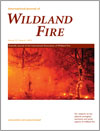International Journal of Wildland Fire
Volume 22
Number 6 2013
We estimated the total carbon release emitted from forest fires in Japan over a 30-year period. While carbon emission varied widely from year to year based on the area burnt, it decreased dramatically from the 1980s onward and was substantially lower than the mean annual net primary production of Japanese forests and carbon releases in other countries and regions.
Approaches for reporting on forest fire-related greenhouse gas emissions in southern Europe were experimentally applied to estimate burnt biomass in forest fire events occurring in Italy during 2008–2010. A reliable range of biomass loss can be derived by methods able to assess variability of local fire effects across different forest types.
The Weather and Research Forecasting model was evaluated for its ability to simulate fire weather in south-east Australia between 1985 and 2009. The model showed considerable skill and is a valuable tool for downscaling climate projections from global climate models. The causes of model error and the effect of model grid spacing were also examined.
Post-windstorm salvage logging and a combination of salvage logging and piling and burning of slash significantly reduced average fuelbed depths, fine woody fuels, fuel consumption and pollutant emissions. We did not find clear evidence treatments reduced potential fire behaviour parameters such as rate of spread, reaction intensity and flame length.
We developed fuel load and fire risk models using measurements of fuel loadings and remote sensing data. We modelled the extensive fires that occurred in the Mojave Desert in 2005, and validated our risk model at a secondary site. This fire risk prediction method could extend to other arid systems.
Post-fire white ash cover correlated significantly to surface fuel consumption at eight prescribed fires across four fuelbed types. White ash cover measured immediately post-fire may provide a physically based, retrospective measure of fuel consumption and fire severity with utility for fire managers, ecologists and modellers of fire behaviour and fire effects.
We determined the soil heat pulse beneath operational burn piles ranging in fuel composition and pile size. Piles dominated by large wood produced extreme temperatures and heat durations of concern to post-fire soil properties. In comparison, the heat pulse beneath slash piles containing a mixture of fuel sizes was moderate.
The equilibrium moisture content (EMC), a key parameter for fuel moisture modelling, was determined for litter from four major tree species in central Europe using three different experiments. Differences between species, sorption directions and experiments were examined and a comparison to literature values was made. Test procedures are recommended for future experiments.
We assessed wildfire effects on a differently thinned young Douglas-fir afforested area of Patagonia, Argentina. Thinning varied from Reineke’s Stand Density Index (SDI) of 900, 700, 500 and unthinned control. Tree mortality decreased as thinning increased, and no trees survived in the control. Plots thinned to SDI 500 or 700 appear to better withstand severe fires and also achieve the highest growing rates.
We tested the idea that native annual plant species would be better for seeding onto post-fire habitats in the western USA compared with commonly planted perennial species. Our results suggest that native annual plant species have potential for use in restoring post-fire habitats but longer-term data are needed to determine future outcomes in plant community composition.
This article describes an analysis of two studies that look at trust between community members and local land management agencies in the context of fire management in Australia and the United States. Findings suggest common characteristics exist and can be focussed on to build trust in both countries.
The relationship between wildfire risk perceptions and mitigating behaviours of wildland–urban interface residents is examined. Exposure to a wildfire program website, having a wood roof, previous experience living in a fire-prone area, age and income are positively related to wildfire risk-mitigating behaviours.
This paper examines household preparedness and responses to the 2009 ‘Black Saturday’ bushfires in Victoria, Australia. Results from a mail survey indicate that although leaving early is the safest response to bushfires, staying to defend can be a viable alternative to evacuation for some people.
We found an overall positive perception of safety climate among members of US federal wildland fire agencies with recent incident experience, with the degree of connection to other positions and units having the strongest influence. Findings indicating that mid-level supervisors are the least connected have implications for high performance and safety.
Using field spectroscopy, this study looks at the key spectral changes of dominant fuel layers in an Australian forest before and after a prescribed burn. Results indicate that vegetation response to fire is greatest ~2 weeks after the burn with recovery signs emerging 6 weeks after the burn.




